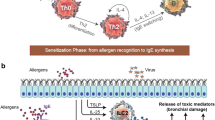Abstract.
The fundamental abnormality in asthma is inflammation of the airways. T-helper 2 (Th2) lymphocytes are the key orchestrators of this inflammation, initiating and propagating inflammation through the release of Th2 cytokines. Interleukins(IL)-4, IL-5 and IL-13. IL-4 and IL-13 promote IgE production by B-cells, mast cell growth and differentiation, and upregulate adhesion molecule expression on vascular endothelium. IL-4 also promotes differentiation of uncommitted Th0 lymphocytes into Th2 lymphocytes. IL-5 promotes differentiation and recruitment of eosinophils and activates them to degranulate within tissues, resulting in damage to the respiratory epithelium. Current treatment of childhood asthma relies predominantly on corticosteroids that have nonspecific anti-inflammatory activity and are associated with potential side-effects. Novel therapies that selectively target the underlying immunopathogenesis hold great promise. Disruption of the Th2 lymphocyte induced allergic inflammatory response represents a novel approach to selectively inhibiting allergic inflammation at its origin. Possible therapeutic interventions include inhibition of Th2 response (CpG oligonucleotides, vaccination, CTLA4Ig fusion protein, IL-12, IL-10), inhibition of IgE (the anti-IgE antibody rhuMAb-E25 omalizumab, which is undergoing clinical trials), inhibition of mediator activity (leukotriene modifiers, which are approved for use in childhood asthma), and targeting Th2 cytokines (soluble IL-4 receptors, IL-5 antibody, IL-13). Other therapeutic approaches targeting downstream events in the allergic inflammatory cascade are also currently under investigation (chemokine receptors CCR3, tryptase inhibitors, and inhibitors of cyclic AMP-specific phosphodiesterase 4). Conclusion: as we further understand the pathophysiology of asthma, the potential to develop novel treatments increases. This paper addresses current possible new treatments for the future.
Similar content being viewed by others
Author information
Authors and Affiliations
Additional information
Electronic Publication
Rights and permissions
About this article
Cite this article
Tang, M.LK., Powell, C.V. Childhood asthma as an allergic disease: rationale for the development of future treatment. Eur J Pediatr 160, 696–704 (2001). https://doi.org/10.1007/s004310100809
Received:
Accepted:
Published:
Issue Date:
DOI: https://doi.org/10.1007/s004310100809




